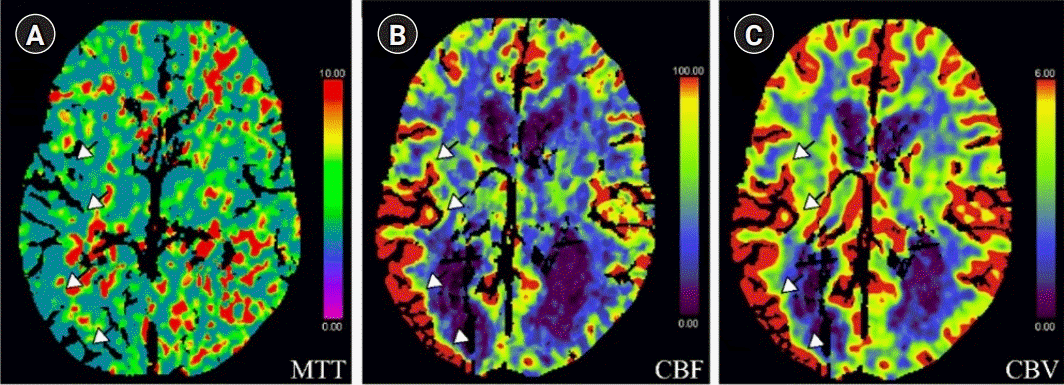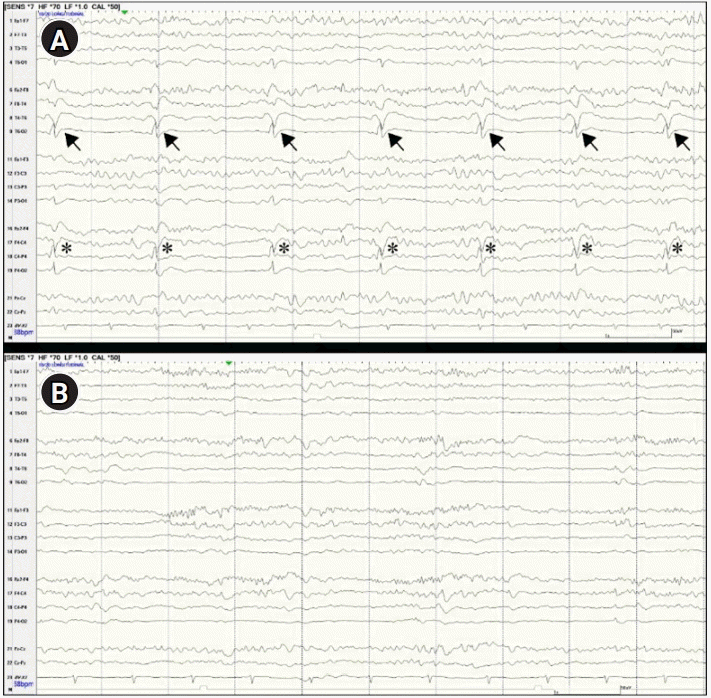INTRODUCTION
Pupillary size and light response are valuable components of neurological examination, especially in the care of critically ill patients when pupillary size and reactivity to light may provide an objective finding of neurological changes. Abnormal pupillary response to light, based on reactivity or pupil size and asymmetry, can be seen in a variety of conditions, ranging from benign or congenital conditions to a life-threating intracranial process [
1]. Fixed and dilated pupils (FDPs) are commonly associated with mass effect in several conditions (vascular, neoplastic, demyelinating, or inflammatory), leading to damage in the midbrain, oculomotor nuclei, or efferent fiber pathways [
2]. Alterations in pupillary light response have been described with seizures [
1,
3]; however, the loss of pupillary response and pathophysiologic mechanism remains unknown in this population. Furthermore, reports of pupillary changes during seizures are often singular events without objective data. We describe a patient with focal status epilepticus with FDPs documented by Neurological Pupil index (NPi) and interpret a possible pathophysiologic correlate on continuous electroencephalogram (cEEG).
CASE REPORT
A right-handed female patient in her late 50s with human immunodeficiency virus (HIV) complicated by recurrent cryptococcal meningitis and seizures was admitted to the neurosciences critical care unit after presenting with bilateral tonic-clonic seizure evolving into focal motor status epilepticus with impaired awareness and left-hand twitching. The patient was compliant with her home regimen of levetiracetam and antiretroviral therapy for HIV. On arrival, she was afebrile, hemodynamically stable, unable to follow instructions, and had notable left-sided hemiparesis.
She was initially treated with lorazepam and lacosamide with resolution of movements; however, persistent tactile stimulation was required to maintain arousal. Ultimately, the patient was intubated to protect the airway. cEEG was started and showed focal slowing over the right parietotemporal region, without clinical events. Over the course of several days, the patient exhibited intermittent left forehead, cheek, and thumb twitching. On cEEG, these movements corresponded with right hemispheric lateralized rhythmic delta activity with sharp waves at 1.5–2 Hz with frequent evolution into well-formed seizures, meeting the criteria for electroclinical status epilepticus (occupying >20% of a 60-minute EEG period) [
4]. Anti-seizure regimen was escalated to valproic acid, levetiracetam, lacosamide, briefly perampanel, and ultimately midazolam and ketamine infusion. The electroclinical motor seizures were controlled with anti-seizure medications; however, EEG continued to be highly epileptiform with near continuous right hemispheric lateralized periodic discharges (LPDs) with sharp wave morphology, occurring at approximately 0.7–1.0 Hz.
Brain magnetic resonance imaging showed cortical restricted diffusion in the right parietal, temporal, and occipital lobes, as well as bilateral temporal lobe encephaloceles with associated encephalomalacia without evidence of a midbrain lesion or effacement of the peri-mesencephalic cisterns. Two lumbar punctures were performed over the course of 1 week given her history of recurrent cryptococcal infections and potential elevated intracranial pressure (ICP) driving her focal seizure activity. The cerebrospinal fluid had a white blood cell count of <3 cells/μL, an red blood cell count of <1 cell/µL, glucose levels of 53 and 79 mg/dL, and protein levels of 23 and 28 mg/dL. The opening pressure was 18 cmH2O.
On hospital day 9, the patient had new FDPs documented by NPi using a NeurOptics NPi-200 pupillometer (Neuroptics Inc., Irvine, CA, USA). Computed tomography (CT) head imaging showed no signs of herniation, and CT perfusion was most consistent with hyper-perfusion in the right temporal and occipital lobes concerning focal status epilepticus (
Fig. 1) [
5]. EEG monitoring showed continuous right hemispheric LPDs (
Fig. 2). Four hours after her initial imaging, she once again developed FDP on examination, and a repeat head CT showed no change.
Fig. 1.
Computed tomography perfusion imaging. (A) Mean transit time (MTT), (B) cerebral blood flow (CBF), (C) cerebral blood volume (CBV), consistent with hyper-perfusion in the right temporal and occipital lobes (arrows).


Fig. 2.
Screenshot of a 10-second clip of an electroencephalogram in bipolar montage displaying, (A) continuous right hemispheric lateralized periodic discharges with sharp wave morphology, occurring at approximately 0.7–0.8 Hz, noted by an arrow and asterisk, coinciding with fixed and dilated pupil (FDP). (B) Ten-second clip of an electroencephalogram following the administration of a 5-mg midazolam bolus with appearing transient improvement of lateralized periodic discharges and resolution of FDP.


Without imaging evidence of ICP increase or mass effect, management was focused on the treatment of focal status epilepticus rather than cerebral herniation. The patient’s pupils were reactive following the administration of a midazolam bolus. Anesthetics were escalated to achieve burst suppression EEG along with escalating anti-seizure medications. She exhibited an abnormal pupillary light response 12 additional times over 4 days (
Supplementary Table 1). More often, she exhibited bilateral pupil dilation (9/12, 75%) with a single event of brisk left pupil and fixed right pupil (approximately 2.3-mm size bilateral) and single event of fixed, dilated left pupil and sluggish right pupil (left pupil dilated approximately 6 mm and right approximately 3 mm). As anticonvulsants were adjusted and a ketogenic diet was initiated, the associated LPDs decreased over the following days with resolution of pupil abnormalities throughout the subsequent 10-week hospital course. Her mental status improved moderately following simple instructions by family members. She underwent tracheostomy and was discharged with close support from her family and therapy teams.
DISCUSSION
The patient displayed FDP on pupillometry, which coincided with the clinical and electrographic occurrence of focal motor status epilepticus and without evidence of third nerve compression in relation to cerebral herniation syndrome. Conversely, FDP using pupillometry resolved the anesthetic escalation and resolution of the right LPDs. Together, these observations suggest a direct relationship between FDP and focal seizures.
Pupil alterations during seizures were described as early as 1881 by Sir William Richard Gowers [
1]. He noted during the course of a generalized tonic-clonic seizure brief episodes of bilateral pupillary miosis during the tonic phase and bilateral pupil mydriasis during the clonic phase. Other studies have reported similar findings of FDP with absence seizures, which were associated with other autonomic symptoms, such as facial flushing, followed by a perceived postictal pupillary miosis [
3]. In a case series of medial temporal lobe epilepsy, 42 of 66 patients who underwent depth EEG for surgical planning had dilated and unreactive pupils to light early in the course of a seizure [
6]. Although the seizure type, localization, and EEG data were not described in a previous study, the FDP appeared to correspond with the onset of impaired awareness. The authors [
6] suggest that seizure spread throughout subcortical midline structures plays a pathophysiologic role in the abnormal pupillary response. Still, cases describing pupillary changes during seizures appear sparse, with less information regarding lateralization, localization, or significance.
Several case reports have discussed lateralization of unilateral mydriasis during several seizure types, termed ictal mydriasis, which is most often focal and associated with conjugate gaze deviation [
7,
8]. In these limited reports, lateralization of pupil dilation is correlated with frontal (contralateral mydriasis) or occipitotemporal (ipsilateral mydriasis) focus localization, albeit with a few exceptions. Studies in macaques and human models have noted a similar association between cortical stimulation and the lateralization of the dilated pupil [
9].
Automated pupillometry is a noninvasive, portable diagnostic technique that provides a standardized quantitative assessment of the patient’s pupils and their pupillary light reflex. These devices generate a standardized light stimulus using an infrared light-emitting diode and capture pupil images before, during, and after the stimulus. These images are then immediately processed to obtain a series of standardized and metric data. Proprietary device-specific metrics include the commonly used and studied NPi, ranging from 0 to 5, with 0 being nonreactive, 5 being fully reactive, and NPi of <3 generally considered to be less than the normal limits.
Changes in pupil size, shape, and light reflex are traditionally interpreted as markers of elevated ICP and cerebral herniation [
10]. The initial concern for brain herniation syndrome, typically uncal herniation, presents with asymmetric pupillary changes, the earliest sign being sluggishly reactive to light, which progresses to dilated and nonreactive to light. Most often, supratentorial mass lesions, such as acute hemorrhage, produce downward compression of the superolateral aspect of the ipsilateral oculomotor nerve or, occasionally, contralateral oculomotor nerve compression [
2]. Automated pupillometry is thought to be a more reliable method for assessing these changes. Changes in NPi have been shown to be correlated with the earlier detection of ICP changes, CT evidence of midline shift and cisternal effacement in stroke, and cerebral herniation [
10,
11]. However, pupillary changes can be associated with any condition that disturbs the balance of autonomic control that regulates pupillary size/shape and not just changes in ICP [
12]. Medications such as barbiturates can alter the pupillary light reflex and can present with a nonreactive pupil [
13]. Lastly, NPi and differences in NPi between the left and right pupils have been found to be predictive of the occurrence and resolution of nonconvulsive status epilepticus [
14].
In our patient, EEG showed LPDs with sharp wave morphology over the right parietotemporal region, occurring 0.7–1.0 Hz in FDP (
Fig. 2A). LPDs are defined as “repetition of a waveform with a relatively uniform morphology and duration, with a quantifiable inter-discharge interval between consecutive waveforms, and recurrence of the waveform at nearly regular intervals, occurring for at least six cycles [
4].” Although there is a consensus definition and agreement regarding LPDs, they represent a diverse EEG pattern with variable clinical and prognostic connotations [
15] and can represent either an ictal or interictal state. In our case, LPDs appeared to be associated with increased blood flow to the corresponding area on perfusion imaging and pupillary abnormalities (electroclinical seizure), suggesting an ictal state.
Our study, as a single case within our academic neurosciences critical care unit, has limited generalizability but presents direct and quantified evidence for the association. However, this observation requires further validation in a cohort of patients.
To our knowledge, this is the first description of objective documentation of symmetric FDP by pupillometry as a manifestation of LPDs in a critically ill patient with return of the pupillary light reflex after management with anti-seizure medications. FDPs may be a clinical manifestation of LPDs. The use of handheld automated pupillometry within the neurocritical care unit, in conjunction with cEEG, provided the therapeutic direction. Further research is warranted to fully describe the mechanistic underpinnings of these observations.



